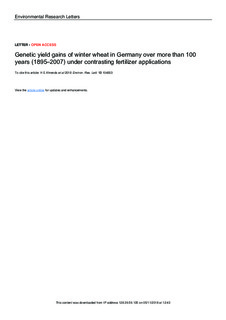| dc.contributor.author | Ahrends, Hella Ellen | |
| dc.contributor.author | Eugster, Werner | |
| dc.contributor.author | Gaiser, Thomas | |
| dc.contributor.author | Rueda-Ayala, Victor | |
| dc.contributor.author | Hüging, H. | |
| dc.contributor.author | Ewert, F. | |
| dc.contributor.author | Siebert, Stefan | |
| dc.coverage.spatial | Germany | nb_NO |
| dc.date.accessioned | 2018-11-06T11:32:33Z | |
| dc.date.available | 2018-11-06T11:32:33Z | |
| dc.date.created | 2018-10-09T09:28:51Z | |
| dc.date.issued | 2018-09-27 | |
| dc.identifier.citation | Environmental Research Letters. 2018, 13 (10), . | nb_NO |
| dc.identifier.issn | 1748-9326 | |
| dc.identifier.uri | http://hdl.handle.net/11250/2571232 | |
| dc.description.abstract | For highly productive regions such as Germany, the increase of wheat grain yields observed throughout the 20th century is largely attributed to the progress in crop breeding and agronomic management. However, several studies indicate a strong variability of the genetic contribution across locations that further varies with experimental design and variety selection. It is therefore still unclear to which extent management conditions have promoted the realization of the breeding progress in Germany over the last 100+ years. We established a side-by-side cultivation experiment over two seasons(2014/2015 and 2015/2016)including 16 winter wheat varieties released in Germany between 1895 and 2007. The varieties were grown using 24 different long-term fertilization treatments established since 1904 (Dikopshof, Germany). Averaged over all cultivars and treatments mean yields of 6.88 t ha−1 and 5.15 t ha−1were estimated in 2015 and 2016, respectively. A linear mixed effects analysis was performed to study the treatment-specific relation between grain yields and year of variety release. Results indicate a linear increase in grain yields ranging from 0.025 to 0.032 t ha−1 yr−1 (0.304 to 0.387% yr−1 )in plots that were treated with combined synthetic-organic fertilizers without signs of a leveling-off. Yields from low or unfertilized plots do not show a significant progress in yield. Responsiveness of mean yields to fertilizer management increases with year of release and indicates small yield penalties under very low nutrient supply. Results highlight the need to consider the importance of long-term soil fertilization management for the realization of genetic gains and the value of long-term fertilization experiments to study interactions between genetic potential and management. | nb_NO |
| dc.language.iso | eng | nb_NO |
| dc.rights | Navngivelse 4.0 Internasjonal | * |
| dc.rights.uri | http://creativecommons.org/licenses/by/4.0/deed.no | * |
| dc.subject | Winter wheat | nb_NO |
| dc.subject | Nutrient supply | nb_NO |
| dc.subject | Grain yield | nb_NO |
| dc.subject | Breeding | nb_NO |
| dc.subject | Genetic gain | nb_NO |
| dc.subject | Fertilization | nb_NO |
| dc.title | Genetic yield gains of winter wheat in Germany over more than 100 years (1895-2007) under contrasting fertilizer applications | nb_NO |
| dc.type | Journal article | nb_NO |
| dc.type | Peer reviewed | nb_NO |
| dc.description.version | publishedVersion | nb_NO |
| dc.rights.holder | © 2018 The Author(s). | nb_NO |
| dc.subject.nsi | VDP::Landbruks- og Fiskerifag: 900 | nb_NO |
| dc.source.pagenumber | 11 | nb_NO |
| dc.source.volume | 13 | nb_NO |
| dc.source.journal | Environmental Research Letters | nb_NO |
| dc.source.issue | 10 | nb_NO |
| dc.identifier.doi | 10.1088/1748-9326/aade12 | |
| dc.identifier.cristin | 1618890 | |
| cristin.ispublished | true | |
| cristin.fulltext | original | |
| cristin.qualitycode | 1 | |

